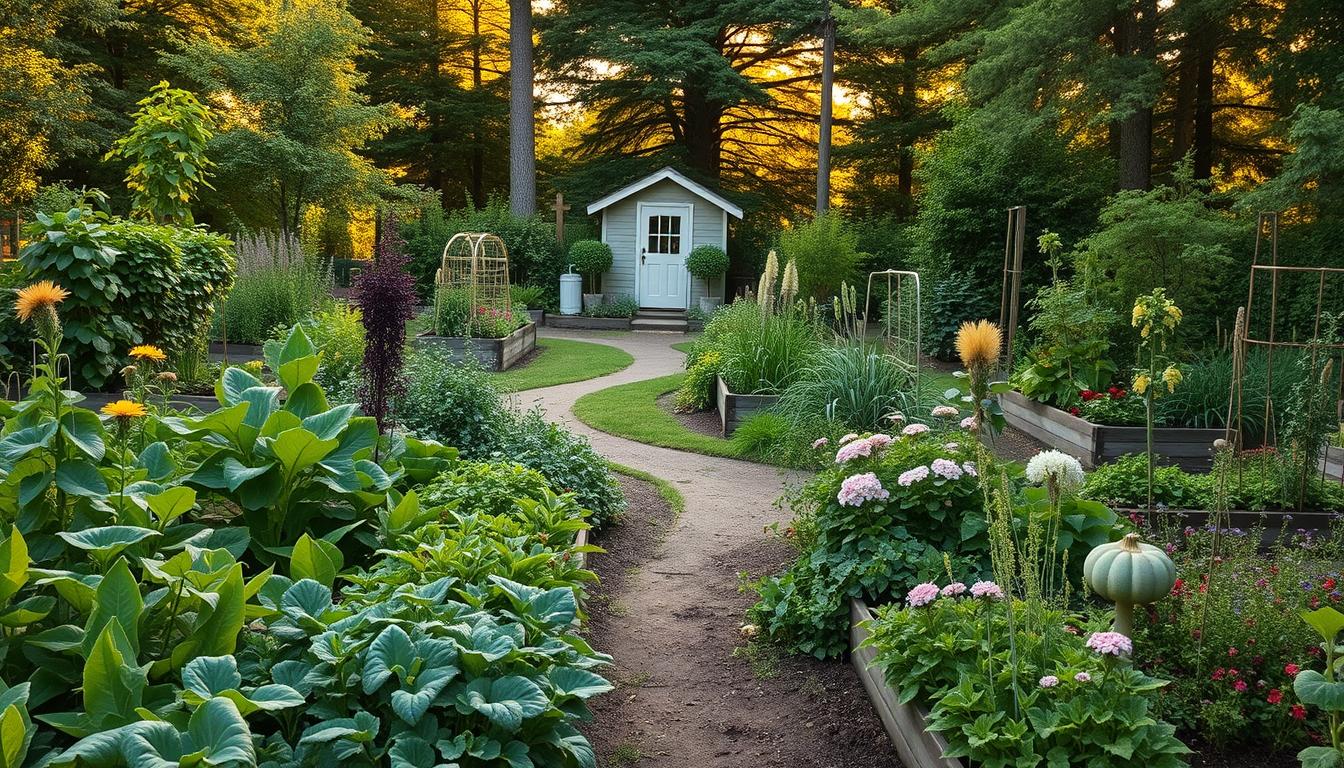Creating a healthy and productive space for your vegetables and plants doesn’t have to be complicated. One effective strategy is companion planting, a method that pairs specific plants to boost growth and deter pests naturally. For example, basil and tomatoes are a classic duo, as basil helps repel insects that target tomatoes.
Tools like the Almanac Garden Planner can simplify the process of designing your layout. By arranging your garden thoughtfully, you can maximize space, improve soil health, and create a balanced ecosystem. This approach not only saves time but also reduces the need for chemical interventions.
In this article, we’ll explore practical tips to optimize your garden’s layout. From natural pest control to space-saving techniques, these strategies will help you cultivate a thriving and sustainable environment for your plants.
Key Takeaways
- Companion planting enhances garden health and yield naturally.
- Basil and tomatoes are a proven pairing for pest control.
- Use tools like the Almanac Garden Planner for layout design.
- Proper arrangement improves space and soil health.
- A balanced ecosystem reduces the need for chemicals.
What is Companion Planting and Why Does It Matter?
Pairing certain species together can unlock hidden potential in your outdoor area. This method, often referred to as companion planting, is rooted in the idea that some species thrive when grown near each other. For example, basil helps repel whiteflies and mosquitoes that target tomatoes, while sage deters carrot flies and cabbage moths.
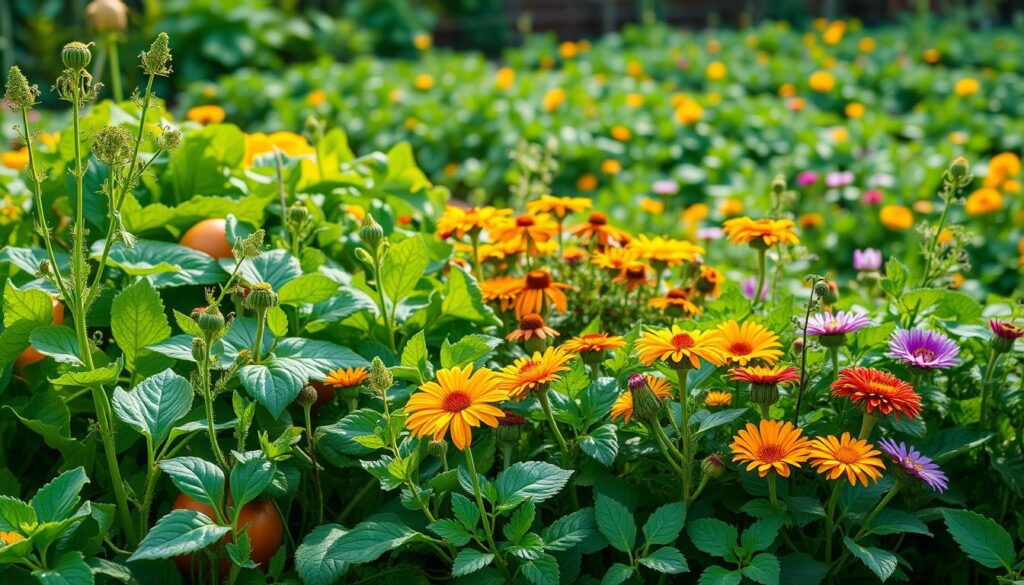
The Science Behind Companion Planting
Nature has its own way of balancing growth and protection. Take the Three Sisters method, where corn, beans, and squash grow together. Corn provides a natural trellis for beans, while beans fix nitrogen in the soil, benefiting all three. Squash spreads along the ground, shading the soil and reducing weeds.
Research from the University of Massachusetts highlights how these pairings improve nutrient uptake. Additionally, marigold root systems combat nematodes, tiny pests that harm crops. These natural relationships create a balanced ecosystem, reducing the need for chemical interventions.
Benefits of a Companion Plant Garden Layout
Strategic arrangements offer multiple advantages. Tall crops like corn protect smaller plants from wind damage. Aromatic herbs, such as basil and sage, naturally repel pests, keeping your space healthier. This approach also maximizes space and improves soil health, leading to better yields.
If you’re new to this concept, starting with simple pairings can make the process easier. By understanding these natural relationships, you can create a thriving and sustainable environment for your crops.
How to Plan Your Companion Plant Garden Layout
Designing a thriving outdoor area starts with thoughtful planning and preparation. By understanding your environment and making informed choices, you can create a balanced ecosystem that supports healthy growth.
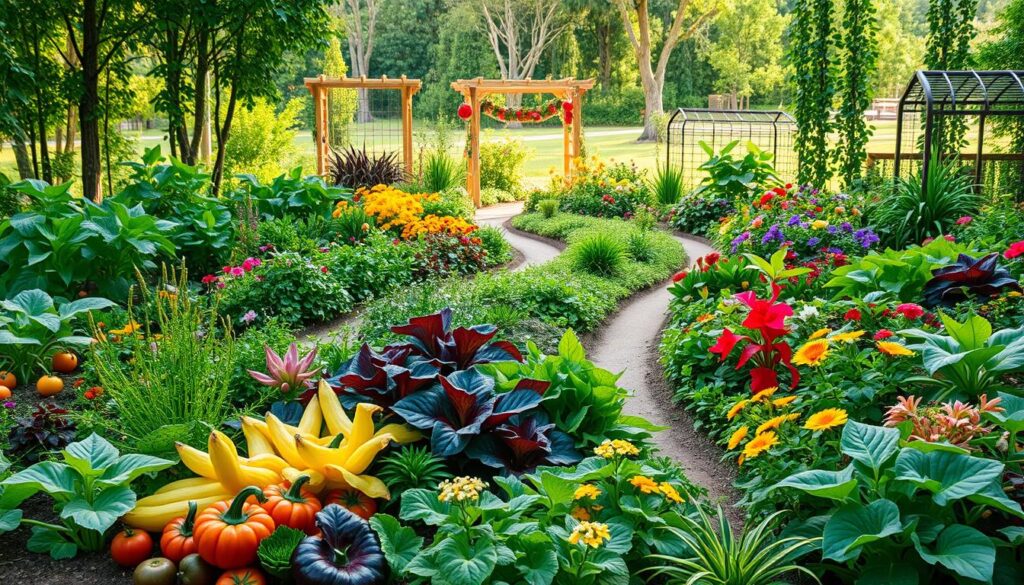
Assessing Your Garden Space and Soil
Begin by measuring sun exposure patterns. Most crops need at least six hours of sunlight daily. Use a garden calendar to track frost dates and plan accordingly.
Test your soil’s pH to ensure it meets the needs of your chosen crops. For example, beans thrive in slightly acidic soil, while onions prefer neutral conditions. Adding compost or organic matter can improve soil health and structure.
Choosing the Right Companion Plants
Select pairings that benefit each other. Beans and peas fix nitrogen in the soil, making them excellent neighbors for nitrogen-loving crops. However, avoid planting peas near onions, as they compete for nutrients.
Use succession planting to maximize your space throughout the seasons. For example, plant quick-growing radishes alongside slower-growing carrots. This approach ensures continuous harvests and efficient use of space.
- Measure sun exposure to ensure proper light for each crop.
- Test soil pH and amend it based on plant preferences.
- Pair nitrogen-fixing beans with nitrogen-loving crops.
- Avoid incompatible combinations like peppers and beans.
- Use seasonal charts for succession planting.
Designing Your Companion Plant Garden Layout
Crafting a harmonious outdoor space requires strategic pairing of species for mutual benefits. By grouping the right species together, you can enhance growth, deter pests, and create a balanced ecosystem. This approach not only improves yields but also reduces the need for chemical interventions.
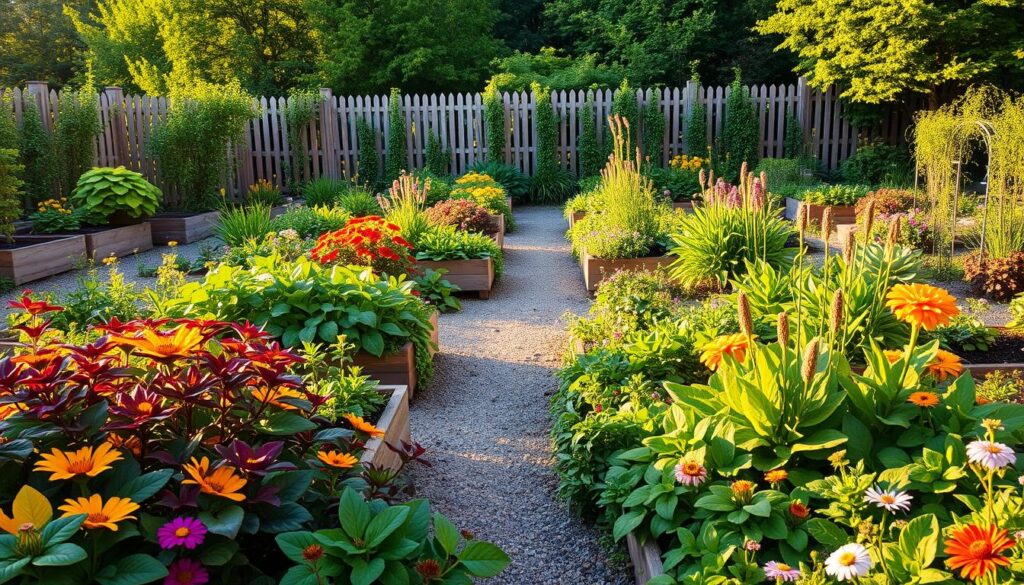
Grouping Plants for Mutual Benefits
One effective strategy is vertical layering. For example, corn can act as a natural trellis for climbing species like beans. This saves space and improves air circulation. Additionally, sunflowers provide shade for heat-sensitive species, ensuring they thrive even in warmer climates.
Pairing onions with Swiss chard is another smart move. This combination deters aphids naturally, reducing the need for pesticides. By understanding these relationships, you can create a thriving environment for your crops.
Incorporating Flowers and Herbs for Pest Control
Adding flowers and herbs to your outdoor space can work wonders. Nasturtiums, for instance, act as trap crops for aphids, drawing them away from your vegetables. Similarly, marigolds combat root-knot nematodes, protecting your soil health.
Here are a few tips to get started:
- Use calendula to attract pollinators for squash and other flowering crops.
- Implement sacrificial cropping by planting species that attract pests away from your main crops.
- Follow Homestead and Chill’s raised bed corner planting strategy for efficient space use.
By incorporating these methods, you can create a balanced and productive outdoor space that thrives naturally.
Implementing Your Companion Plant Garden Layout
Turning your outdoor area into a thriving ecosystem starts with smart implementation. By following a clear plan, you can ensure your garden maximizes space and yields. Tools like the Almanac Garden Planner simplify this process, helping you arrange your bed effectively.
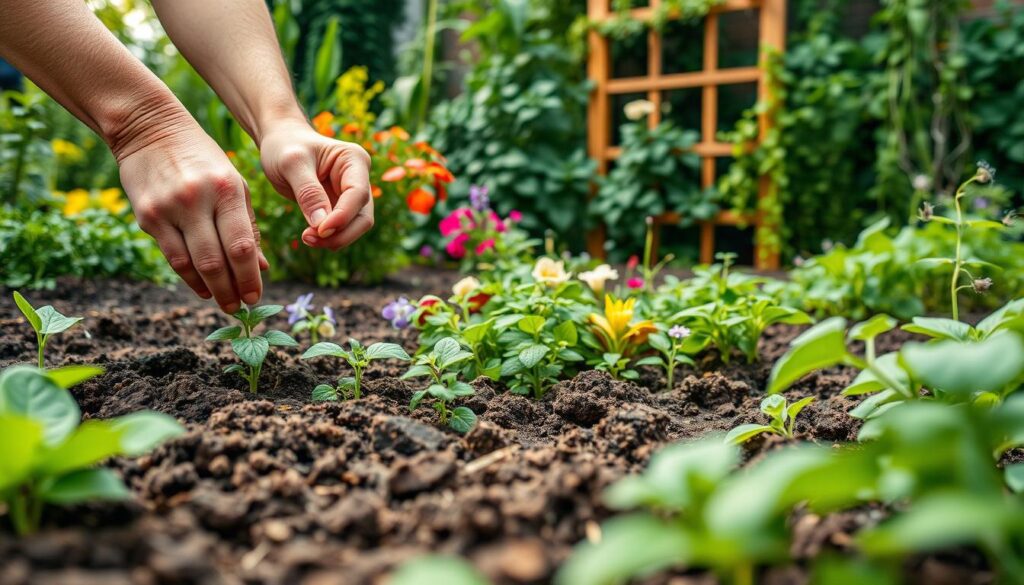
Step-by-Step Planting Guide
Begin by transplanting key pairings at the right time. For example, tomatoes, basil, and marigolds thrive when planted together. Space them 18-24 inches apart to allow room for growth. Quick-growing radishes can be intercropped with slower crops like cucumbers to maximize your bed.
Succession planting is another effective strategy. After harvesting early crops like leafy greens, replant the area with peppers or beans. This ensures continuous productivity throughout the season.
Tips for Maximizing Space and Yield
Prune flowers from vegetable crops to redirect energy into producing more edible parts. For example, removing blossoms from tomatoes encourages fruit growth. Vertical planting is another space-saving technique. Use trellises for climbing plants like beans or cucumbers.
Consider adding boho yard decor ideas to enhance your space while keeping it functional. By combining these strategies, you can create a balanced and productive garden that thrives naturally.
Maintaining Your Companion Plant Garden
Keeping your outdoor space healthy and productive requires consistent care and attention. Proper watering, fertilizing, and pest management are essential for sustaining a balanced ecosystem. By following these tips, you can ensure your area thrives naturally.

Watering and Fertilizing Tips
Schedule deep watering to encourage strong root development. This method ensures moisture reaches the root zone, promoting healthier growth. For nitrogen-fixing species like beans, compost tea is an excellent natural fertilizer. It enriches the soil and supports nutrient uptake.
Here’s a quick guide to watering and fertilizing:
- Water early in the morning to reduce evaporation.
- Use compost tea every two weeks for nitrogen-loving crops.
- Mulch around plants to retain moisture and regulate soil temperature.
Managing Pests and Diseases Naturally
Introduce habitat zones for predatory insects like ladybugs. These beneficial creatures feed on harmful pests, keeping your area balanced. Trap cropping, such as planting dill or cilantro, attracts pests away from your main crops.
Garlic-chive spray is an effective natural remedy. It deters pests without harming beneficial insects. Additionally, pepper roots can prevent Fusarium rot, a common soil-borne disease.
| Method | Benefit |
|---|---|
| Trap Cropping | Attracts pests away from main crops |
| Garlic-Chive Spray | Natural pest deterrent |
| No-Till Marigold Roots | Retains soil health and combats nematodes |
By incorporating these strategies, you can maintain a thriving and sustainable outdoor space. Natural solutions not only protect your area but also enhance its overall health.
Conclusion: Start Your Thriving Companion Plant Garden Today
Starting a thriving ecosystem in your outdoor space is easier than you think. Many have seen success with companion planting, where basil and tomatoes or beans and corn grow harmoniously. These pairings not only boost growth but also naturally deter pests.
Don’t be afraid to experiment. Personal observation is key to finding what works best for your area. Use a printable companion chart to guide your plan and ensure balanced growth.
Biodiversity is your ally. Mixing flowers, herbs, and vegetables creates a natural defense against pests. Ready to get started? Begin with seeds today and watch your space transform into a thriving, sustainable haven.

